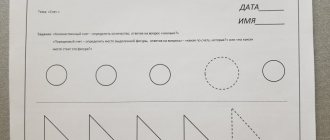Middle group. Junior preschool age. Children 4 - 5 years old
Card index of games on eidetics for children of the middle group Eidetics is a branch of psychology that studies eidetism as a type of figurative memory and the possibility of its practical application in different spheres of human life. Eidetics uses all the child’s analyzers: it allows not only to see, but also to touch, hear,...
Card index of games for speech development in the middle group using the Pop It toy Card index of games for speech development in the middle group using the Pop It toy. No. 1Game “If you hear the word”
Goal: To develop auditory perception, speech hearing. Progress of the game: Option 1: The teacher pronounces the words. Assignment: children press a blue circle if they hear...
Concept
A card index is a record of documents arranged in alphabetical order. There may also be a distribution by deadlines and topics. Thanks to the fact that everything is located in one department of the enterprise, finding any information will not be difficult.
What is a card index in a library? These are catalogs that allow you to quickly find books of interest, because all readers come to receive specific information. Without them, it would be difficult to navigate any library.
Medical databases
If, with the advent of electronic books, people go to the library much less often, preferring to download everything and read on a computer, then a medical file is something that one has to deal with against one’s own will.
In any medical institution (no matter public or private), each patient has his own card. It stores all the secrets about his health (symptoms, test results, treatment, doctor’s orders, extracts from the medical history).
It is interesting that although all these “cards” are in practice more like brochures or small books, they continue to bear their traditional name. The thing is, this system initially really consisted of cardboard cards with data, after which this document is named.
Like all other filing systems, medicine is now widely computerized in more developed countries. We are still just getting there. However, there are already several programs adapted to our realities for maintaining a database of patients, recording the services provided to them in hospitals, clinics and other medical institutions. True, they are specialized for paid clinics, where they are used most often.
Features of filing cabinets in hospitals
The filing cards include essential patient information. There you can find information about your health status, medical history, and prescribed medications. The document allows you to transfer data from one doctor to another.
Cards are stored on special racks, where everything is arranged in alphabetical order. Furniture for documentation can be ordered to specific sizes. The racks have a depth of 18-25 cm and a width of 1000 mm. Many companies manufacture custom-made furniture based on customer preferences.
There is mobile rail furniture for the archive department. It will help compactly place the necessary materials in small areas. The reception area may have stationary shelving or combined furniture. Properly placed documentation will allow you to quickly find the card you need.
Library
The literature card file occupies an important place in an educational institution. Readers receive information about it thanks to:
- visual information;
- events, conversations, excursions;
- days of bibliography;
- publication of manuals;
- use of forms and methods of library activities.
The system of catalogs and cards in the library is managed through planning, coordination, and control. The work of employees in this area consists of drawing up plans, developing documentation, and monitoring completed activities. Each library card is subject to maintenance and editing, for which employees are responsible according to their job description.
Didactic games in the preparatory group according to the Federal State Educational Standard
In the preparatory group, children are preparing for school, so it is important to select educational games that form elementary school knowledge, develop intelligence, logic, memory, speech, and imagination.
Story from pictures
Prepare story pictures for the game and place them in order on the table. Set one card aside and ask your child to look at it carefully. The player’s task is to correctly insert the picture in a row so as not to disrupt the plot, then compose a story based on the resulting composition.
Find the sound
For the game, make cards depicting different objects. Under the images there are line signs, as in “Field of Miracles,” in which the number of squares is equal to the number of sounds in the word.
Encourage children to find specific sounds in words. Players take turns naming the depicted object so that the given sound is clearly heard, then color in this phoneme in the square.
Geometric bridge
To play, cut out large geometric shapes from cardboard, several of the same. Place them on the floor in random order. The player’s task is to go from one corner of the room to the opposite, moving only along given figures, for example, along triangles.
The game can be complicated by including color in the gradation, in addition to shape. For example, you can only move along yellow squares.
Finish the sentence
The leader says the beginning of the phrase, the children take turns continuing:
- light during the day, at night...;
- white snow, grass...;
- a cow moos, a dog...;
- sweet sugar, lemon...;
- In spring the leaves are green, in autumn...;
- a car is moving, a plane...;
- a snake crawls, a bird...;
- lunch during the day, in the evening...;
- they look with their eyes, with their ears...;
- knitted from threads, from fabric...
Superfluous word
Name a series of words, and the child must say which one is superfluous and give reasons for his opinion:
- dress, skirt, coat, sandals, sweater;
- daffodil, nettle, tulip, poppy, rose;
- cow, pig, roe deer, sheep, horse;
- orange, blue, transparent, red, purple;
- wardrobe, stool, sofa, chest of drawers, window;
- bear, hare, wolf, fox, lynx;
- run, rush, think, hurry, hurry;
- sad, gloomy, sorrowful, gloomy, joyful;
- apple, orange, cucumber, pear, peach.
Who will be who?
Name a natural object, and the children must say what it will become in the future. For example:
- lamb is a sheep;
- egg - chicken;
- child - adult;
- caterpillar - butterfly;
- bud - flower;
- foal - horse;
- caviar - fish;
- acorn - oak.
Name it in one word
Say a series of words, and the children should name the concept that unites them:
- tit, duck, nightingale, stork - birds;
- wolf, bear, fox, marten - animals;
- pasta, soup, cutlet, salad - food;
- beets, potatoes, carrots, radishes - root vegetables;
- cucumber, tomato, pepper, eggplant - vegetables;
- sandals, shoes, boots, boots - footwear;
- birch, poplar, spruce, aspen - trees.
Document storage rules
The archive is maintained by a special employee who works on the basis of a job description. The employee ensures the reception, recording and storage of documentation. It carries out information and reference activities, as well as organizational and methodological ones.
At each enterprise, the archive is located in a separate room. Only as an exception, racks, cabinets, and safes are used that perform the function of preserving documentation. Their shelf life is determined to be 3 years, but it can be reduced.
After this period has expired, it is determined whether the document will be used or archived forever. There is also a destruction option. What exactly needs to be done is decided on the basis of an expert commission.
Directory types
The card file includes many catalogs, which may differ in purpose, coverage of the fund, grouping method, technology of creation and use.
If we consider the purpose, then catalogs are for readers and for service purposes. They contain, for example, information of interest to readers. Based on the coverage of collections, catalogs can include useful information about institutions, as well as about specific library departments.
According to the grouping method, cards are:
- alphabetical;
- systematic.
The first is presented in the form of a catalog where the data is listed in alphabetical order. To quickly find the book you need, you need to find the author's name or the title of the work. Using such a catalog is very convenient.
A systematic catalog is a catalog in which information is located by field of knowledge. For this purpose, the principles of library and bibliographic classification are used, which prescribe the rules for grouping information. Considering the type of creation and use, file cabinets can be traditional or electronic.
Banking industry
What is a card index in a bank? This term implies accounting for payment documents that the bank has not fulfilled. The institution keeps them under control. The file cabinet can be of different types, depending on the reasons for unpaid obligations.
These may be orders that were not executed due to lack of funds. Then the employee registers the document in electronic and paper form. This payment will be in an off-balance sheet account. The account owner is informed that the document has been queued. Once received, the funds are credited to the desired account. The file cabinet stores documents that require consent to perform a payment transaction, as well as those that are awaiting their turn.
The presence of a file cabinet indicates that the company has an unstable financial position. If the account owner does not have it, then the bank offers a line of credit or an additional one. financing.
The sequence is the order in which payment orders are executed. It is approved by law. Documents are not processed ahead of the queue. If the account has the required amount, then everything goes by date. If the necessary funds are not available, the following queue is established:
- execution of orders for damage compensation;
- payment of salaries, sick leave, vacations;
- tax payments;
- sending money to funds;
- other requirements.
Didactic games according to Federal State Educational Standards in the senior group
In the senior group, educational and cognitive games, familiarity with nature, surrounding objects, phenomena and properties of objects are required. We must not forget about outdoor activities and general physical development. It is important to continue to acquaint preschoolers with emotions, norms of communication and social interaction, teach them productive teamwork, clear expression of thoughts and constructing a conversation.
A big secret
For a group game, prepare a box, put small objects or cards depicting them in it. Seat children at a distance from each other.
Approach each player in turn and offer to take an item out of the box without looking inside. The pulled out item remains secret; the player must not show it to his comrades. The players’ task is to find out by any verbal means what this secret thing is. Can:
- ask the holder of the item leading questions;
- persuade, beg the player to reveal the secret;
- offer a gift for revealing a secret;
- offer to reveal your secret in return.
It is important to ensure that players do not deceive each other. The game ends when the last player tells his secret. If a player becomes stubborn and refuses to reveal a secret, you need to gently push him to change his behavior, instill in him the importance of being open, friendly, and sociable.
Show me the word
The game task is to depict a given word through facial expressions and body movements. The presenter says, for example, “little bear.” Then he calls one of the players and asks him to imitate what was said. Then he pronounces another word - “loves”, calls the second participant, asks him to depict this verb. The rest of the players say in chorus what their comrades are pretending to say: “The little bear loves...”. Next, the presenter asks you to come up with a third word that will complete the phrase. Players name different options: honey, berries, sleep, play.
Group items
For the game, prepare about 20-25 items and place them on the table. Invite students to divide them into groups according to quality characteristics:
- large;
- small;
- wooden;
- plastic;
- metal;
- edible;
- inedible;
- colored;
- transparent.
Remember the place
Children are seated in different places in the playroom. Each player remembers where he sits. To do this, he can use landmarks: nearby objects, toys, furniture, interior elements.
Turn on the music. The players jump up, run around the hall, and dance. When the music is interrupted, the children must remember where they were sitting and take their place. At the second stage, the game can be complicated: children should not sit in their original place, but move a few steps along the movement of the arrow.
Talking portrait
The game teaches the skill of a coherent story. To carry it out, prepare portraits in which the people depicted express different emotions and are in different settings. Invite the students to take turns telling about themselves on behalf of the depicted character.
To play you need a regular envelope. Children stand in a circle, choose one of the players to be the “postman”, he becomes and gives an envelope, for example, to Misha. He says: “The letter comes from Misha Katya.” Children standing in a circle quickly pass the envelope to each other until it falls into Katya’s hands. The task of the “postman” is to have time to snatch the “letter” before it reaches the “addressee”. When he succeeds, the player from whose hands the envelope was snatched becomes the “postman”.
The meaning of the word "card index"
This term was coined by the ancient Greeks. Translated from their language, it meant “a place for storing sheets of papyrus.” Over the millennia that have passed since then, the semantics of the word “card file” has not changed much. And today this is the name given to a collection of cards with data laid out in a certain order.
The purpose of filing cabinets is to preserve and organize information. And also make it easier to find. Therefore, the cards are arranged according to the selected criterion. Most often in alphabetical order. Less often - by year, address, number, topic, last name, etc.
Also, a filing cabinet is also specialized furniture for storing the above-mentioned collections. Sometimes this is the name given to the room or department where they are located.
In fact, over the millennia since the emergence of this concept, only the material of the cards has changed in its structure and meaning from papyrus to cardboard.
Card file of arbitration cases
The judicial system has mastered new trends much faster than the medical system. At the moment, in most countries of the world, computer databases are being created that contain information on cases that are or have been before arbitration courts of all levels and entities.
In the Russian Federation this is the Card Index of Arbitration Cases. It is a website kad.arbitr.ru, where, using various search parameters, you can find all the necessary data about the court decision, if for some reason they are not classified. This resource inherited its name from a system used in the pre-computer era. While in the same Ukraine, a site with such data is called not a “card index”, but a “register” (“Unified State Register of Ship Decisions”).
And also about the law enforcement system. As is known, from the moment of its formation, all countries of the world began to keep records of persons who had previously committed crimes or were suspected of them.
Today, all this information is no longer stored in dusty folders, but has been digitized and entered into computer databases.
In the Russian Federation, the “Card Index” program has been developed to store information from the forensic expert department of the Ministry of Internal Affairs and about registered persons. We can assume that its name is another way of interpreting the term in question.






